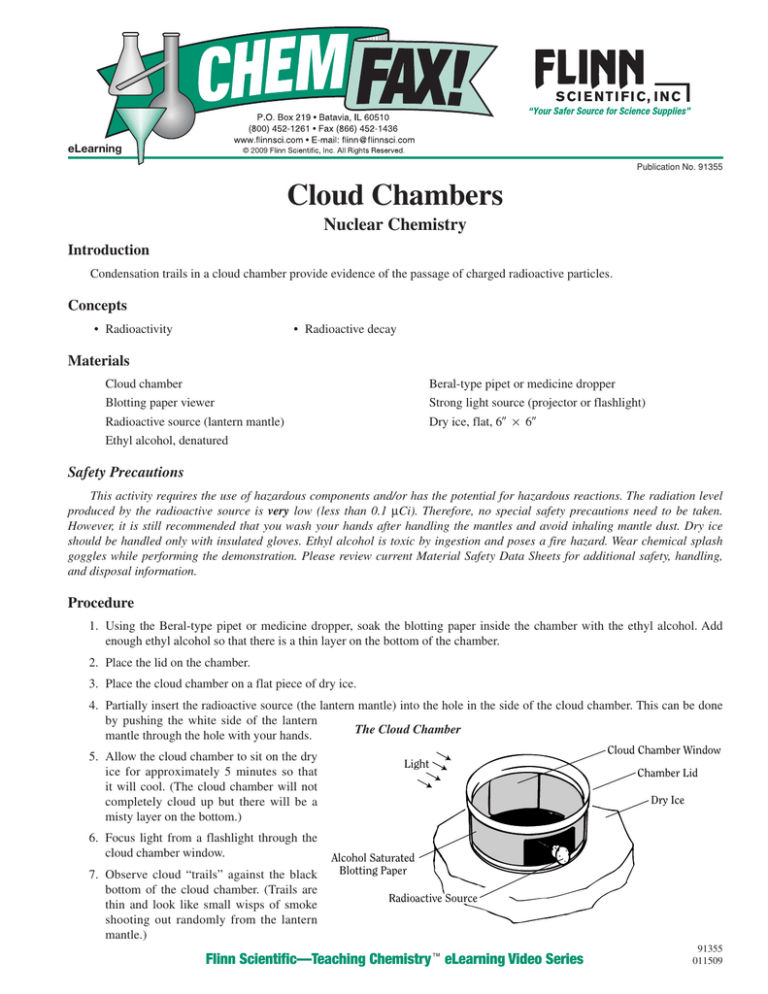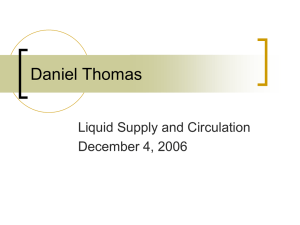
eLearning
2009
Publication No. 91355
Cloud Chambers
Nuclear Chemistry
Introduction
Condensation trails in a cloud chamber provide evidence of the passage of charged radioactive particles.
Concepts
• Radioactivity
• Radioactive decay
Materials
Cloud chamber
Blotting paper viewer
Radioactive source (lantern mantle)
Ethyl alcohol, denatured
Beral-type pipet or medicine dropper
Strong light source (projector or flashlight)
Dry ice, flat, 6 × 6
Safety Precautions
This activity requires the use of hazardous components and/or has the potential for hazardous reactions. The radiation level
produced by the radioactive source is very low (less than 0.1 μCi). Therefore, no special safety precautions need to be taken.
However, it is still recommended that you wash your hands after handling the mantles and avoid inhaling mantle dust. Dry ice
should be handled only with insulated gloves. Ethyl alcohol is toxic by ingestion and poses a fire hazard. Wear chemical splash
goggles while performing the demonstration. Please review current Material Safety Data Sheets for additional safety, handling,
and disposal information.
Procedure
1. Using the Beral-type pipet or medicine dropper, soak the blotting paper inside the chamber with the ethyl alcohol. Add
enough ethyl alcohol so that there is a thin layer on the bottom of the chamber.
2. Place the lid on the chamber.
3. Place the cloud chamber on a flat piece of dry ice.
4. Partially insert the radioactive source (the lantern mantle) into the hole in the side of the cloud chamber. This can be done
by pushing the white side of the lantern
The Cloud Chamber
mantle through the hole with your hands.
5. Allow the cloud chamber to sit on the dry
ice for approximately 5 minutes so that
it will cool. (The cloud chamber will not
completely cloud up but there will be a
misty layer on the bottom.)
6. Focus light from a flashlight through the
cloud chamber window.
7. Observe cloud “trails” against the black
bottom of the cloud chamber. (Trails are
thin and look like small wisps of smoke
shooting out randomly from the lantern
mantle.)
Cloud Chamber Window
Light
Chamber Lid
Dry Ice
Alcohol Saturated
Blotting Paper
Radioactive Source
Flinn Scientific—Teaching Chemistry eLearning Video Series
91355
011509
Disposal
The dry ice can be allowed to evaporate in a well-ventilated area. The blotting paper can be allowed to dry, and the entire
cloud chamber kit can be reused. The lantern mantles can be used indefinitely and can be stored in a plastic bag.
Discussion
The radioactive source in the lantern mantle is thorium nitrate, Th(NO3)4. The thorium in the compound is thorium-232, a
radioactive element which has a half-life of 1.4 × 1010 years and is an alpha-particle emitter. Alpha (α) particles are nuclear particles which are essentially helium nuclei, consisting of two neutrons and two protons. Therefore, they have a mass of 4 and a
charge of +2, and are written as 42 He. Alpha particles are one of the three basic types of ionizing radiation resulting from nuclear
decay. The others are beta (β) and gamma (γ) radiation. Beta particles have almost no mass and either a positive or negative
0 β. If the β-particle has a positive
charge. If the β-particle has a negative charge, it is identical to an electron and it is written as –1
charge, it is known as a positron, and it is similar to an electron except that it has a positive charge. A positron is written as 01β.
Gamma radiation, or gamma rays, are high-energy photons having no mass and no charge, and they are written as 00γ.
The reaction for the alpha decay of Th–232 is:
232
90
Th 씮
228 Ra
88
+
4 He
2
Actually, the lantern mantles do not produce only α-particles. As thorium undergoes radioactive decay, “daughter elements”
such as Ra–228 are produced. Ra–228 also undergoes radioactive decay, with a half-life of 5.8 years, and produces a β-particle.
The reaction for the beta decay of Ra–228 is:
228
88
Ra 씮
228 Ac
89
+
0
–1 β
The cloud chamber, also known as a fog chamber, shows the path of the radioactive particles. The particles cause ethyl alcohol
vapor present in the chamber to condense. It is these liquid ethyl alcohol droplets formed in the path of the particle that are visible.
Connecting to the National Standards
This laboratory activity relates to the following National Science Education Standards (1996):
Unifying Concepts and Processes: Grades K–12
Evidence, models, and explanation
Constancy, change, and measurement
Content Standards: Grades 5–8
Content Standard B: Physical Science, properties and changes of properties in matter
Content Standards: Grades 9–12
Content Standard B: Physical Science, structure and properties of matter
Reference
Heiserman, D. L. Exploring Chemical Elements and Their Compounds; TAB Books: New York, 1992; pp 288–290.
Flinn Scientific—Teaching Chemistry™ eLearning Video Series
A video of the Cloud Chambers activity, presented by Steve Long, is available in Nuclear Chemistry, part of the Flinn
Scientific—Teaching Chemistry eLearning Video Series.
Materials for Cloud Chambers are available from Flinn Scientific, Inc.
Materials required to perform this activity are available in the Cloud Chamber Kit available from Flinn Scientific. Materials
may also be purchased separately.
Catalog No.
AP8807
AP4389
E0012
AP2253
Description
Cloud Chamber Kit
Flashlight
Ethyl Alcohol, 500 mL
Pipets, Beral-type, Pkg/20
Consult your Flinn Scientific Catalog/Reference Manual for current prices.
–2–
© 2009 Flinn Scientific, Inc. All Rights Reserved.
91355



